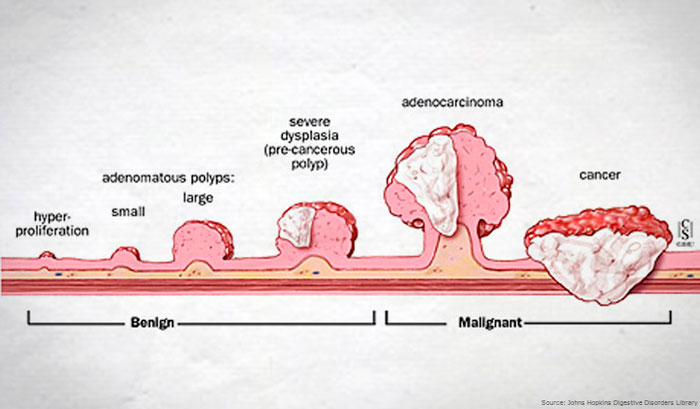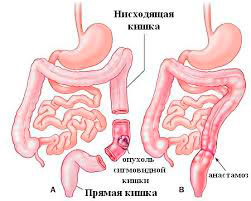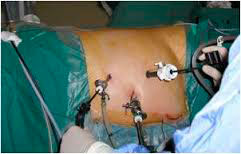
When a physician diagnoses colon cancer, or colorectal cancer, cancer of colon or rectum is meant. That being said, its should be noted that intestines include several sections: the duodenum, the jejunum, the segmented intestine and the rectum. Why is it than that physicians associate rectum with segmented intestine under the title of “intestines”? The answer to this lies in disease statistics. In our country, for example, rectum and segmented intestine cancer account for 5% of all the oncological diseases. This places these disorders in the second place among all of the cancer-related diseases. Oncological diseases of the duodenum and jejunum account for only 0.1% of cases. Thus, the majority of cancer occurrences falls on segmented intestine and rectum disorders.
How does colorectal cancer progress?

In most cases, the development of colorectal cancer starts at the mucosal lining. Quite frequently, cancer develops from an already-existing benign neoplasm, or polyp. Over time, the tumor causes the lumen of the intestines to diminish thus hindering passage of food. By invading blood vessels and damaging them, the tumor may cause hemmorhage. With the advancement of the disease, cancer cells may penetrate bowel walls and attach to adjacent organs like stomach, pancreatic gland, liver, kidneys or urinary bladder. In neglected cases, metastases may appear in liver or lungs.

What is the colorectal cancer risk group?
The exact causes of colorectal cancer are unclear. Nevertheless, certain factors enhance the likelihood of its development:
- age of over 50 years;
- In persons affected by chronic colitis, Crohn disease or nonspecific ulcerative colitis. Cases when the above disease exists for more than 10 years are especially threatening.
- Life style: excessive weight, low levels of physical activity, a diet with high quantities of fat or ingredients of animal origin. Excessive consumption of alcoholic beverages and smoking.
- Hereditary factors: familial adenomatous polyposis (in certain cases of this disease, physicians may discuss the option of preemptive excision of colon); Lynch syndrome (a familial disorder where cancer develops directly from the mucous lining of the intestine bypassing the polyp stage).
- Positive family history, that is, known cases of colorectal canter in close relatives.
It should be noted that occurrences of intestinal polyps is also a risk factor.
What are the symptoms of colorectal cancer?
It should be pointed out, that clinical manifestations of colorectal cancer may be revealed at some advanced stages. However, the disease may also manifest itself through bowel disorders:

- diarrhea, constipation, increased or decreased frequency of bowel movement;
- appearance of mucus or blood in stool (there may be very little blood in stool);
- feeling of stuffed or blotted stomach;
- feeling of incomplete bowel evacuation;
- unexplained loss of weight, general weakness;
- painful sensation in the colon;
- feeling of a lump in the colon;
- abdominal pains;
- exhausting anemia.
Prevention measures
Presently, there is no vaccine which would rule colorectal cancer out. Elimination of risk factors may help to decrease the likelihood of cancer, but not prevent it completely. Because of this, colorectal cancer prevention activities are aimed today at earliest possible detection of the pathology.
Our Center, SI “Republican Clinical Health Care Center” of the Administration of the President of the Republic of Belarus, performs comprehensive examinations to reveal early stages of colorectal cancer. The main method used is fibrocolonoscopy, a technique which involves an examination of the intestines using a fibrocolonoscope following special procedures to prepare the bowels for the study. (Shown in the image). The examination involves removal of all revealed polyps and their histological study. Besides, biopsy samples are taken of all suspicious abnormally changed sections of colon and rectum. In order to make the procedure more comfortable to patients, fibrocolonoscopy is performed at our Center with intravenous anesthesia.
How is colorectal cancer treated?
The main method of colorectal cancer therapy is surgical intervention. In certain cases it may be supplemented by chemotherapy or radiation therapy.
The operation essentially involves the excision of the tumor together with the affected section of the intestine and  its inosculation, that is, suturing of its edges. (Shown in the image). In most clinics, a large laparotomy incision is used to gain access to the abdominal cavity. This results in an unattractive scar tissue.
its inosculation, that is, suturing of its edges. (Shown in the image). In most clinics, a large laparotomy incision is used to gain access to the abdominal cavity. This results in an unattractive scar tissue.
Our Center uses a different technique of surgical treatment of colorectal (colon and rectal) cancer. This is a long-established procedure employed by foreign clinics. Due to certain reasons, the technique is scarcely used in Belarus. At our Center, resection of colon and rectum to treat malignant pathologies is performed with the use of the laparoscopical technique.
 To access the abdominal cavity, we use a number of laparoscopical instruments (shown in the image). This method makes it possible to remove the affected part of the intestine, including mesentery, via a small opening in the abdominal cavity, and perform the necessary scope of lymph node dissection procedures. The technique is minimally traumatizing to the patient while enabling medical professionals to maintain all the oncological standards of surgical treatment of the pathology.
To access the abdominal cavity, we use a number of laparoscopical instruments (shown in the image). This method makes it possible to remove the affected part of the intestine, including mesentery, via a small opening in the abdominal cavity, and perform the necessary scope of lymph node dissection procedures. The technique is minimally traumatizing to the patient while enabling medical professionals to maintain all the oncological standards of surgical treatment of the pathology.
Quite naturally, for patients operated with the use of this technique, the postoperative period is much less stressful as compared to patients operated using the “open” method. The more attractive aesthetic result is also quite obvious.
We would also like to draw your attention to unique rectum operations performed at our Center. Our Center offers laparoscopical sphincter-preserving operations of malignant rectum diseases that do not require intestinal ostomy through the anterior abdominal wall. This definitely improves quality of life of our patients and results in an satisfactory cosmetic effect.



